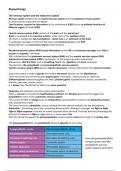Class notes
AQA A level psychology biopsychology notes
- Course
- Institution
- Book
These notes contain everything you need to know about each of the biopsychology on the specification for AQA A level psychology! This includes a large amount of AO1 and following 4 evaluations in PEEL format for any possible 16 markers. In a very few cases there will be 3 but each of them are detai...
[Show more]




